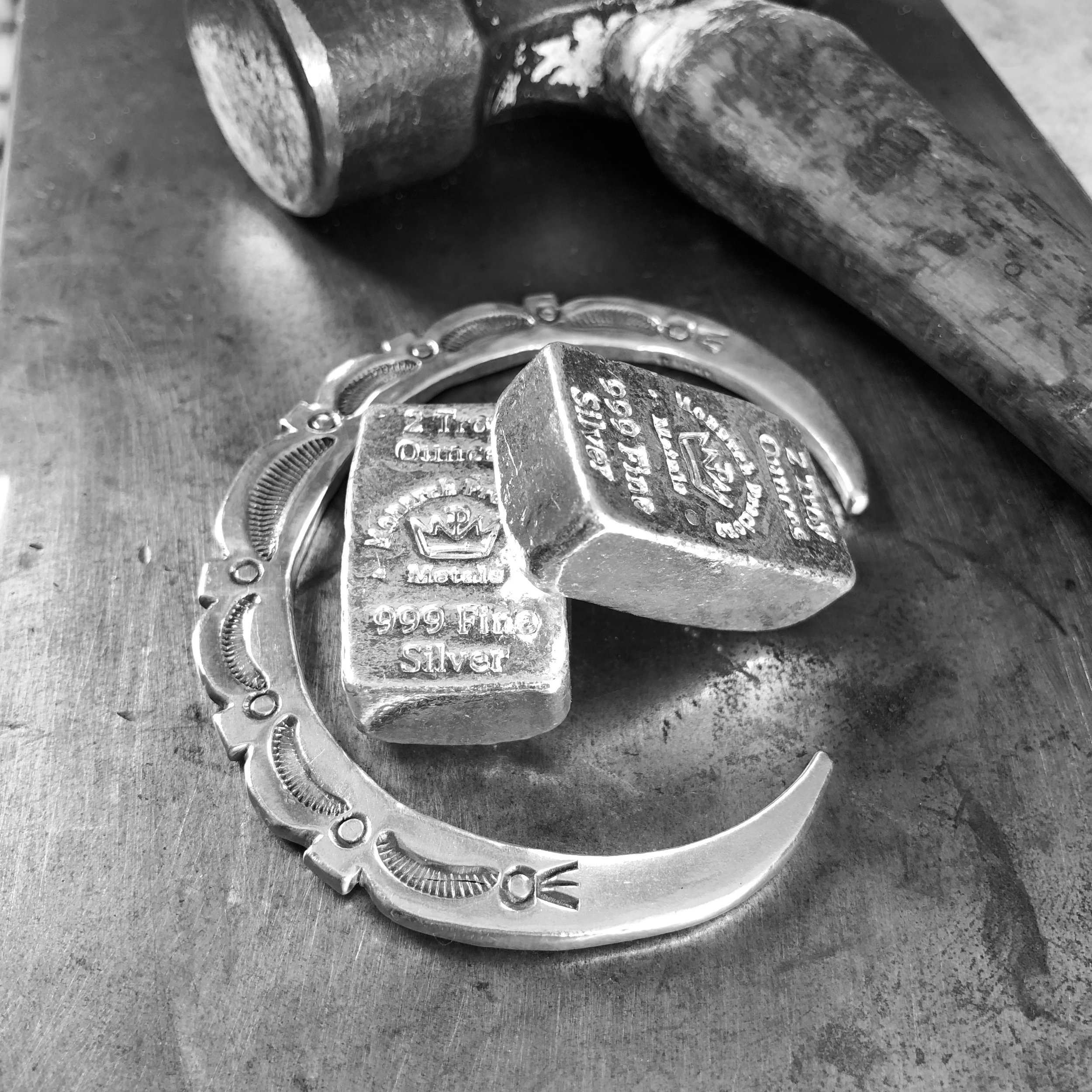With My Own Two Hands
If you aren't familiar with metal forging, let me give you a little behind the scenes insight about what it takes to hand forge a piece of silver jewelry. To start, let me just say, it's a lot of work. I mean, if you really don't care much about how your jewelry came to be, I would say don't go for handmade. There's nothing wrong with not caring. Machined jewelry is almost always cheaper and with more symmetry and perfection in other ways. What you are really paying for when you buy handmade is time, skill and generally better materials.
Each hand forged bracelet starts as an ingot. I use fine silver ingots (.999) for the Chiricahua cuff bracelets. I like the bright white finish it gives. On other bracelets, I might use a sterling silver ingot (.925), or coin silver ingot (~.900) made by melting down various silver pieces and pouring the molten silver into a mold.
The first step is firing up the forge. I use a propane forge. Coal burning forges are super cool and old school but they are also very messy and inconsistent with heat. The ingot is heated to a dull orange color. This is called annealing. I could go into all the juicy information about metallurgy and atoms and crystallization and whatnot, but I won't. I'm surprised you've read thus far. If you are still reading, you are probably a person that buys handmade because you value the process and that means I like you. You're my people. But I digress.
Once the ingot is annealed, you start pounding. Fine silver is fairly soft so I'm able to use my regular trusty hammer to work it, but there's still a fair amount of elbow grease involved in this process. Forging is hot and messy and I love it. You know who else loves it? My husband. He made me those special little twisty tongs out of steel. Yes, I do have my own personal blacksmith.
Voilà! After you've sweated out half your body weight, you have a rough cuff shank, similar to a handmade prison shank. I'm the girl you want to know if you ever find yourself in prison. I personally have no plans to go to prison any time soon, but the summer is drawing long and family togetherness is getting tedious, so you never know.
The shank is stamped and forged into an oval. The metal stamps I use are made by Native Americans. Stamp carving is an art unto itself and there are some amazing Navajos making stamps today. I have a few stamps carved by my personal blacksmith that I love for obvious reasons.
I snapped the above photo of handmade stamps when I was in Lyndon Tsosie's workshop in Gallup, New Mexico. His collection of stamps is something to behold. If you look closely you can see that all sorts of scrap steel is used to make stamps. Rebar is pretty common, as are large nails and small pieces of rectangle rods.
A saw is then used to remove excess silver from the stamped design.
And then there's the filing. Oh the filing. So much filing. I can usually get through at least one, if not two podcasts while I file. I use mostly hand files during this process. As I'm nearing the end I'll use my handheld rotary tool for the finest sanding. The cuff is then given a patina (the stuff that stays black so the stamping stands out) and filed again to remove the excess. At this point I'm hours into making the cuff. I've become so attached to it I'm sure I can never sell it. I have visions of my great granddaughter wearing it on her wedding day. It goes in the tumbler for a couple hours to give it a high shine. It might need another patina when it comes out which requires more filing and another short tumble. This is when I realize that I need to sell this cuff so I can buy more silver to make the cuff design I've just come up with in my head. You know, the one my great granddaughter is going to wear for sure.
I didn't really pay attention to how long the first Chiricahua cuff took to make. I had so much fun replicating the old design that I wasn't keeping track of the hours I put into it. I had no plan to sell it. But I did, and this time around I put on my big girl business pants and kept track of time. So you might have noticed a slight increase in the price of these cuffs. Sorry, not sorry.
I think there must be people like me out there that want a piece of jewelry because of the history of the craft and the blood -- yes blood -- sweat, tears and skill that went into making it. I've got some amazing tools that the early Navajo silversmiths didn't have. My forge is better, my rotary tool makes buffing go faster and my tumbler saves me from manually shaking a can with jewelry in it for two hours straight. But, for the most part I'm going through the same process they used to work silver. I think when you look at my pieces you can see the difference that makes. Some people would say it makes it look crude and rudimentary and to that I say "Thank You."










